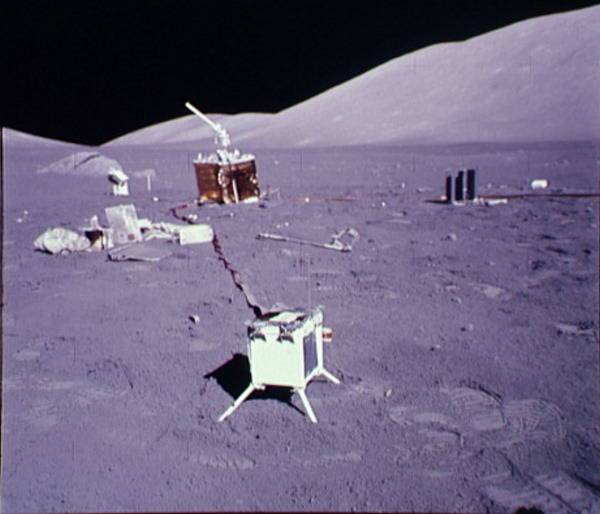Exhibit #11
Moon Storms
Levitating Dust Clouds follow the Terminator
A Tale from NASA

Image Credit: NASA/JPL
An old Apollo experiment is telling researchers something new and surprising about the moon.The box in the foreground is the Lunar Ejecta and Meteorites Experiment (LEAM).
Moon Storms
12.07.2005
+ Play Audio | + Download Audio
December 7, 2005: Every lunar morning, when the sun first peeks over the dusty soil of the moon after two weeks of frigid lunar night, a strange storm stirs the surface.
The next time you see the moon, trace your finger along the terminator, the dividing line between lunar night and day. That's where the storm is. It's a long and skinny dust storm, stretching all the way from the north pole to the south pole, swirling across the surface, following the terminator as sunrise ceaselessly sweeps around the moon.
Never heard of it? Few have. But scientists are increasingly confident that the storm is real.
"To everyone's surprise," says Olhoeft, "LEAM saw a large number of particles every morning, mostly coming from the east or west--rather than above or below--and mostly slower than speeds expected for lunar ejecta."
What could cause this? Stubbs has an idea: "The dayside of the moon is positively charged; the nightside is negatively charged." At the interface between night and day, he explains, "electrostatically charged dust would be pushed across the terminator sideways," by horizontal electric fields. (Learn more: "Moon Fountains." )
It's even possible that these storms have been spotted from Earth: For centuries, there have been reports of strange glowing lights on the moon, known as "lunar transient phenomena" or LTPs. Some LTPs have been observed as momentary flashes--now generally accepted to be visible evidence of meteoroids impacting the lunar surface. But others have appeared as amorphous reddish or whitish glows or even as dusky hazy regions that change shape or disappear over seconds or minutes. Early explanations, never satisfactory, ranged from volcanic gases to observers' overactive imaginations (including visiting extraterrestrials).
Now a new scientific explanation is gaining traction. "It may be that LTPs are caused by sunlight reflecting off rising plumes of electrostatically lofted lunar dust," Olhoeft suggests.
All this matters to NASA because, by 2018 or so, astronauts are returning to the Moon. Unlike Apollo astronauts, who never experienced lunar sunrise, the next explorers are going to establish a permanent outpost. They'll be there in the morning when the storm sweeps by.
The wall of dust, if it exists, might be diaphanous, invisible, harmless. Or it could be a real problem, clogging spacesuits, coating surfaces and causing hardware to overheat.
Which will it be? Says Stubbs, "we've still got a lot to learn about the Moon."
SOURCE PAGE: Moon Storms NASA
So sunset and sunrise rays in a saffron colored sky while raging dust storms sweep around the Moon...
Not quite the picture NASA USED to show us
 Coming Soon
Coming Soon
Prof. Johann Hansen and the Atmosphere discrepancy on the Lunar Farside